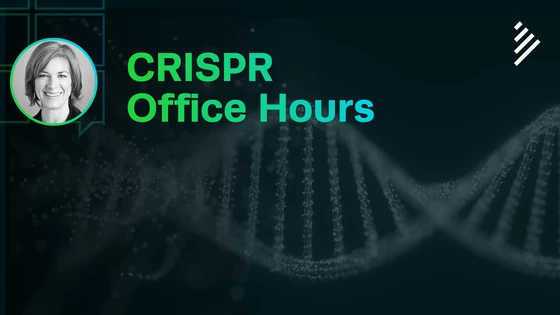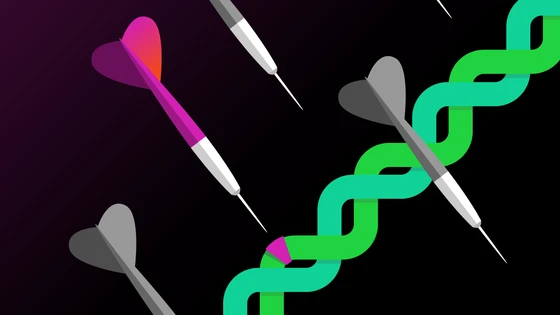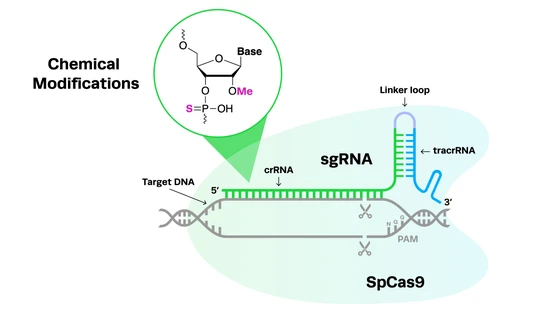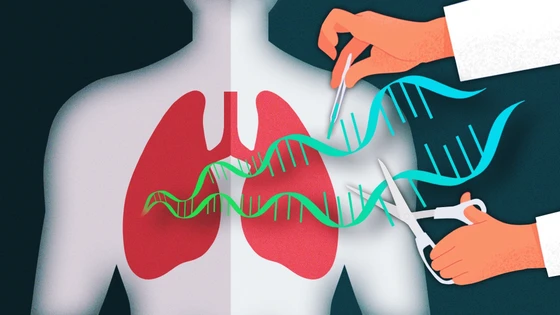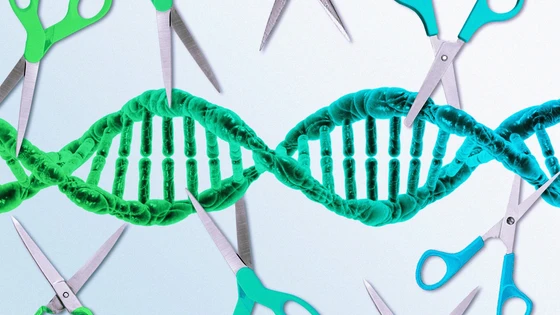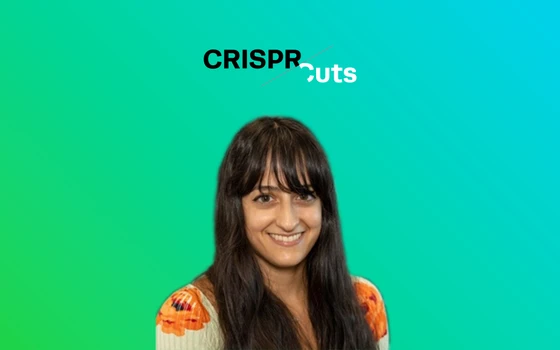In the latest CRISPR Office Hours, we were joined by none other than the mother of CRISPR herself—Jennifer Doudna, Ph.D. In this episode, she briefly gave an overview of CRISPR technology, discussed its applications, and spoke about some of her recent exciting projects, including CRISPR diagnostics for COVID-19.
Specifically, the following main topics were covered
- Speaker Profile: Dr. Jennifer Doudna, CRISPR Co-Inventor
- Dr. Doudna Explains Mechanism & Applications of CRISPR
- Move over Cas9, Doudna Lab Finds Miniature CasΦ
- Innovative Genomics Institute COVID-19 Testing
- Notable Questions: Pick a couple from youtube video
- More Resources Featuring Dr. Jennifer Doudna
Watch the recording here, or jump down and read the summary — the choice is yours!
Speaker Profile: Dr. Jennifer Doudna, CRISPR Co-Inventor
Dr. Jennifer Doudna is a researcher that needs no introduction in the field of genetics. In 2012, she co-discovered that CRISPR Cas9 enzymes could be used for genome editing-- a monumental finding that revolutionized the field of gene editing. Dr. Doudna is a Professor in the Department of Chemistry and the Department of Molecular and Cell Biology at the University of California, Berkeley, and investigator at the Howard Hughes Medical Institute. She is also the President and Chair of the Innovative Genomics Institute (IGI) Governance Board.
Dr. Doudna Explains Mechanism & Applications of CRISPR
Doudna briefly explained how CRISPR technology works. In the 2012 paper that she published in collaboration with Emmanuelle Charpentier and her lab members, the researchers reported how Cas9 worked with the crRNA and tracrRNA to interact with DNA in a programmable fashion at a 20 letter sequence that matches the CRISPR sequence resulting in a double-stranded break induced by the Cas9 protein. Subsequently, this led to the transformational discovery that the system could be re-engineered as a single guided system by linking together the crRNA and the tracr RNA as a single-guide RNA (sgRNA). This sgRNA provided the target information on one end and the structural handle for binding to Cas9 on the other.
Dr. Doudna also spoke about some of the potential applications of CRISPR. She gave the example of sickle cell anemia where CRISPR editing has been used for the treatment by correcting the disease-causing mutation. Recently, CRISPR Therapeutics, a company started by Emmanuelle Charpentier reported that a patient,
Move over Cas9, Doudna Lab Finds Miniature CasΦ
Recently, in collaboration with Dr. Jill Banfield’s lab at UC Berkeley, Dr. Doudna’s team found that they are big phages that infect bacteria in the environment and those big phages carry around their own CRISPR systems. They discovered that these phages use a compact CasΦ protein to trick bacteria into fighting off rival viruses instead of itself. CasΦ is one of the smallest Cas proteins known to date; the small size of this protein makes it a lot easier to deliver it into cells as compared to Cas9 and could help solve many problems associated with the latter.
Innovative Genomics Institute COVID-19 Testing
Dr. Doudna also discussed her involvement in the development of novel CRISPR-based COVID-19 diagnostic, and how she spearheaded the transformation of the IGI into a high-throughput COVID-19 testing facility.
Their diagnostic test uses the Cas13 protein which targets the RNA instead of the DNA. For Cas13, when the RNA guided protein interacts with an RNA target sequence, the protein turns on its RNA cutting activity. However, it is not restricted to the sequence of RNA that it is bound to and is able to cut other RNA molecules in its vicinity. So, when these RNA molecules are hooked onto fluorophores, a signal can be detected when this RNA gets cut. Cas12, which targets DNA also had similar abilities and could be used for diagnostics as well. For more information on CRISPR diagnostics for COVID-19, check out this blog.
Notable Questions From the Audience
As you might already know, our CRISPR Office hours episode is not complete without questions from the audience. This week, we had a number of great questions and we have selected a few to discuss below.
Doudna’s Advice to Junior Female Faculty to Establish their CareersWhen asked for career advice for female scientists, Dr. Jennifer Doudna says “Go for your biggest and most exciting ideas and don’t let anyone tell you that it won’t work.” She said that in her career, she encountered numerous people with opinions telling her that an idea was “silly” or that an experiment wouldn’t work. She said her advice to both male and female researchers starting out would be to trust their judgment and passion.
When asked for career advice for female scientists, Dr. Jennifer Doudna says “Go for your biggest and most exciting ideas and don’t let anyone tell you that it won’t work.” She said that in her career, she encountered numerous people with opinions telling her that an idea was “silly” or that an experiment wouldn’t work. She said her advice to both male and female researchers starting out would be to trust their judgment and passion.
What Breakthrough Should Biologists Focus on Next For Enhancing Disease Treatments?Dr. Doudna believes that the key was to advance genome editing technologies. For example, inserting very large pieces of DNA into the genome would be tremendously useful and there is definitely room for breakthroughs in that area, according to her. She also said that solving the delivery problems associated with CRISPR technology would enable researchers to accelerate therapies as well.
Dr. Doudna believes that the key was to advance genome editing technologies. For example, inserting very large pieces of DNA into the genome would be tremendously useful and there is definitely room for breakthroughs in that area, according to her. She also said that solving the delivery problems associated with CRISPR technology would enable researchers to accelerate therapies as well.
Resources Featuring Dr. Jennifer Doudna
Interested in learning more about Jennifer Doudna and her work? We have put together a list of resources for you to check out.
Books and Notable Publications by Dr. Jennifer Doudna
- A Crack in Creation: Gene Editing and the Unthinkable Power to Control Evolution
This book authored by Jennifer Doudna is a great book to learn about CRISPR and will get you thinking not just about the possibilities but also the ethical consideration.
- A programmable dual-RNA-guided DNA endonuclease in adaptive bacterial immunity
The paper that made CRISPR what it is today! Make sure you don’t miss this one.
- A Crack in Creation: Gene Editing and the Unthinkable Power to Control Evolution
This book authored by Jennifer Doudna is a great book to learn about CRISPR and will get you thinking not just about the possibilities but also the ethical consideration. - A programmable dual-RNA-guided DNA endonuclease in adaptive bacterial immunity
The paper that made CRISPR what it is today! Make sure you don’t miss this one.
Dr. Jennifer Doudna’s Ted Talks & Interviews
- The Future of Humans: Gene Editing & the Unthinkable Power to Control Evolution
Jennifer Doudna, Ph.D., joins oncologist Siddhartha Mukherjee to discuss the advancements in gene editing and the impact on humanity.
- How CRISPR lets us edit our DNA
Watch this Ted Talk to learn about CRISPR gene editing from none other than the pioneer herself!
- CRISPR Talk with Jennifer Doudna
Don’t miss this recent Jennifer Doudna interview where she answered questions on the future of healthcare.
- The Future of Humans: Gene Editing & the Unthinkable Power to Control Evolution
Jennifer Doudna, Ph.D., joins oncologist Siddhartha Mukherjee to discuss the advancements in gene editing and the impact on humanity. - How CRISPR lets us edit our DNA
Watch this Ted Talk to learn about CRISPR gene editing from none other than the pioneer herself! - CRISPR Talk with Jennifer Doudna
Don’t miss this recent Jennifer Doudna interview where she answered questions on the future of healthcare.
With that, we have now come to the end of CRISPR Office Hours. We hope you have enjoyed attending our sessions and found them useful. For recaps of any of the past episodes, check out our recap blog posts and Youtube channel.
Free CRISPR Consultation
Want to know how to optimize your CRISPR experiment to get guaranteed editing results? Schedule a free discovery call and project consultation with a genome engineering expert.

